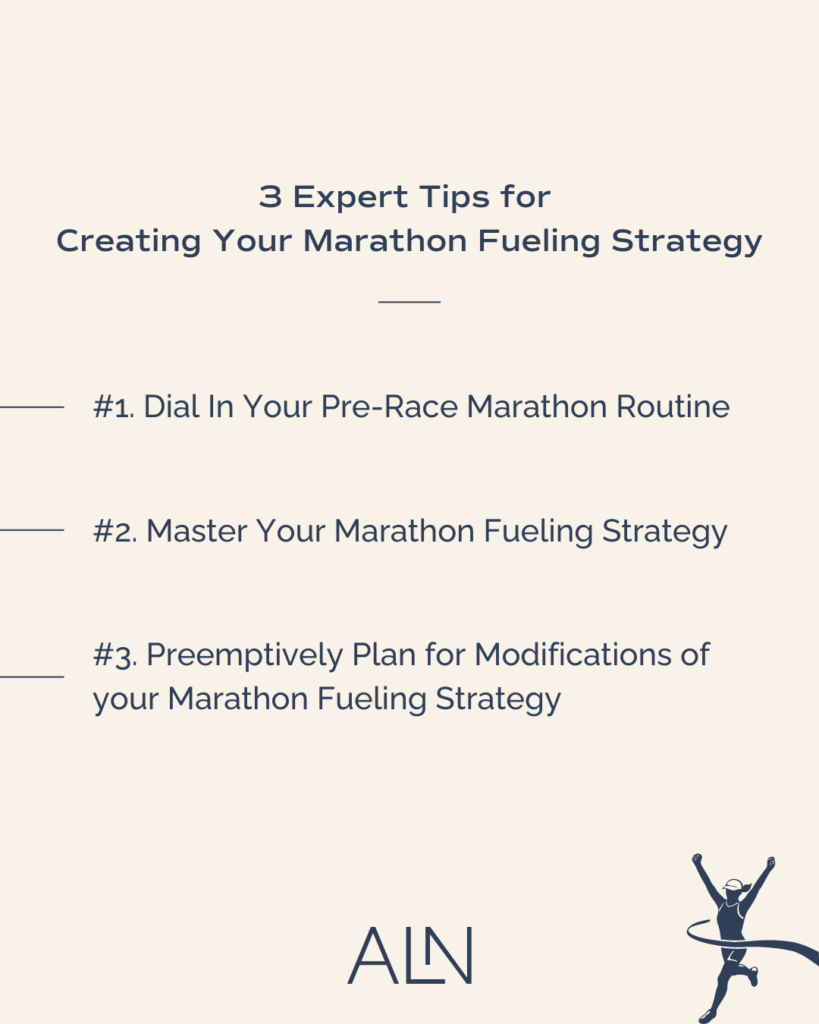RUNNING →
Level Up Your Nutrition Game With Our Freebies
Alex
I provide nutrition coaching for endurance athletes to improve performance and body composition through a simple and flexible eating style.
Hi, I'm
ATHLETE EATING GUIDE →
PROTEIN →
TRIATHLON →
RECIPES →
PERFORMANCE NUTRITION →
SUPPLEMENTS →
HOLIDAY & TRAVEL →
PLANT-BASED →
FEMALE ATHLETE NUTRITION
Explore the Blog
LEARN MORE →
ATHLETE GROCERY SHOPPING GUIDE →
RACE DAY: TRIATHLON NUTRITION PLANNER →
READY TO FUEL?
incredible value!
The fueling guide bundle serves as your one-stop-shop for strategies to fueling before, during and after your workouts.
ENDURANCE EATS
BINGE-WATCH READY!
YOUTUBE SERIES
A proper marathon fueling strategy is the hallmark of success for long-distance runners. Fueling (or lack thereof) can make or break a race– even for the best-intentioned athlete. It ensures that athletes have the energy, stamina, and mental focus needed to conquer the grueling 26.2-mile race.
I have worked with countless athletes who have had the most dialed-in training cycle but unfortunately have fallen short of their goals due to poor nutrition. We want to keep you off of the sidelines– for good. So let’s review 3 expert tips from your dietitian bestie for optimizing your marathon fueling strategy.
Understanding Your Body’s Marathon Fueling Needs

The science behind marathon fueling is a balance between tapping into the body’s energy reserves efficiently. Marathon runners predominantly rely on two primary sources of energy: glycogen and fat to fuel those logged miles. Glycogen is stored in the muscles and liver and serves as the body’s readily available energy source. Whereas fat provides a more abundant, but slower-burning energy reserve.
In the early stages of a marathon, runners primarily rely on stored glycogen– hello carb load! However, these glycogen stores are limited and unfortunately typically last for about 90 minutes to 2 hours of continuous exercise. Once glycogen stores start depleting, the body shifts to metabolizing fat for energy. Fat can provide a near-limitless energy source, but it’s slower to convert into usable energy compared to glycogen. This transition can lead to the dreaded “hitting the wall” or “bonking” if not managed effectively.
To optimize marathon performance, runners need a fueling strategy that supports glycogen utilization while also fueling subsequent miles. This involves consuming carbohydrates before and during the race to maintain enough energy intake. So let’s review how to optimize your marathon fueling strategy.
#1. Dial In Your Pre-Race Marathon Routine
Be confident in your training plan that got you to the actual race start line. And, I want you to be as equally as confident in your carbohydrate (“carb”) loading as part of your prep for the big day. Because what you eat before race day is arguably just as critical as what you eat during the race. Carb loading is an important strategy for runners to use so they are adequately fueled heading into a big race. Some research shows as much as a 2-3% increase in performance following a high carbohydrate intake.
Eating carb-rich foods before race day can help maximize your glycogen stores, which is your source of stored energy. On the flip side, inadequate glycogen stores on race day can lead to unnecessary fatigue and decreased endurance. To avoid this, many endurance athletes use carb loading to increase the amount of glycogen stored in their muscles and liver. These extra glycogen stores can convert into increased stamina and endurance for your upcoming race or big training session.
Here is a carb-loading testimonial from one of my endurance athlete clients.
“Wow! I didn’t think I would have so much energy. Super-hero level of energy, in fact. I was a little unenthused by the volume of carbohydrates that I needed before my race because I didn’t think I could consume that much food. Working with a sports dietitian made the carb load less daunting and now I am such a believer. I didn’t think carb-loading would have this profound of an impact.”
Carb-loading involves consuming higher amounts of carbs than normal approximately 1-3 days before the race start. If this sounds daunting, don’t worry, we have a whole carb-loading guide post for you! As you get race-ready, consider planning your carb load in advance. Also avoid experimenting with new foods during your carb load and on race day. Furthermore, it is always best to trial your carb load several times during your marathon training cycle to ensure you tolerate it.
Marathon Fueling Strategy: What to Eat Race-Day Morning
Each individual is very different in what foods work well on race day morning but the parameters of what to include are generally the same. At least 2 hours before the race starts, you want to optimize carbohydrate, sodium, and fluid intake. If your body requires more time to digest the meal adequately, set an early alarm. It may be necessary to wake up at least 3 hours before the start of the race to allow enough time. Morning meal ideas to consider include:
- Cream of rice cereal with maple syrup and Skratch hydration beverage
- Toast with salted almond butter and honey and Tailwind hydration beverage
- Pre-made pancakes topped with maple syrup and juice mixed with UCAN
- If traveling- a brown sugar oatmeal packet with an applesauce pouch and Skratch hydration
- If you are eating hotel breakfast- low-fiber bagel with peanut butter and jelly, a banana, and a glass of orange juice
As the saying goes, “Never try anything new on race day morning.” So save the all-you-can-eat continental breakfast of eggs benedict for your next marathon-free vacation!
After you have locked down the pre-race routine of your marathon fueling strategy, it is important to optimize your intra-race fueling plan.
#2. Master Your Marathon Fueling Strategy

Adequate practice and preparation are key for what to eat during a marathon. Ideally, you have practiced this on most, if not every, long run throughout your marathon training cycle. There is no one-size-fits-all approach to sports nutrition for endurance athletes, but in general, for most runners, the recommendation is to aim for:
- 60-90 g of carbohydrates per hour,
- 200-500 mg of sodium per hour, potentially more if you’re a salty sweater
- and 5-10 oz of fluids every 15 minutes during the race (potentially more if the weather is hot, humid, or at altitude)
Simple carbohydrates that are portable and easy to carry, such as energy gels and sports drink beverages, are the most convenient options for hitting these nutrition goals. There is a wide variety of sports nutrition products with various taste profiles. So I encourage athletes to try a wide variety to see what they like the best!
Here is a testimonial from one of my endurance athletes on intra-race fueling.
“We trialed and experimented with a lot of different fueling strategies throughout my training cycle. Fortunately, we nailed down my race day nutrition plan perfectly heading into race day and I was able to execute it to a tee! Hello 12-minute PR and BQ!”
#3. Preemptively Plan for Modifications of your Marathon Fueling Strategy
The last step of your marathon nutrition strategy is– well, planning for when things may not go according to the plan! I often tell my athletes that “hope is not a strategy.” And sometimes with your nutrition and fueling plan, you may have to preemptively plan for modifications. Certainly, there are instances like when you are heading to altitude that may require a few tweaks, though that it is easier to plan in advance. Unfortunately, some modifications may need to be made last minute. These include:
Unwanted gastrointestinal distress.
A runner’s worst nightmare can come from seemingly nowhere and nearly knock you out. To limit the risk of unwanted gastrointestinal issues, be sure to limit high-fat, high-fiber foods heading into race day. If you have a finicky stomach mid-race, remember that liquid calories get digested quicker than solid foods. Continue to focus on hydration and hitting your nutrition goals through sports drinks versus gels and solids. Also, be cautious with caffeine which may have a laxative effect and lead to more damage. Be sure to review our thorough blog post on easing a runner’s stomach for more strategies.
The weather is looking too hot (and humid) for comfort.
Beyond the dreaded runner’s trots, an overwhelmingly hot and humid forecast is looking less than ideal. To prepare for race day, it is always important to start well-hydrated at baseline. According to the National Academy of Sports Medicine, the recommended fluid intake for men is 125-130 oz/day (approx. 16 cups) and 91-95 oz/day (approx. 12 cups) for women. In addition to bumping up your fluid intake, consider including more hydrating foods such as fruits and smoothies in your carb-loading plan before race day. Your sweat rate is likely increased and for some individuals, may be double the sweat rate in normal weather conditions.
Fluids and salt will need to be a priority throughout the race. Opt for high-carb, high-salt energy gels, and sports drinks in your race day nutrition plan. Salt tabs or capsules are also an easy and portable way to boost your sodium intake during the race.
This is a non-exhaustive list of how to preemptively plan for race day. If you are feeling less than prepared, be sure to reach out! Working with a sports dietitian can boost your confidence heading into race day!

Ready, Set, Let’s Go!
As athletes, we harness the ability to maintain flexibility with our race day nutrition plans. Each individual has very unique nutrition needs and it is important that you feel just as confident in your fueling plan as you do with your training and racing plan. Nailing down your marathon fueling strategy requires consistent practice and patience, which can be the hardest part! Consider working with a sports dietitian so that you can better tailor a marathon fueling strategy that works for you!
Alex
I provide nutrition coaching for endurance athletes to improve performance and body composition through a simple and flexible eating style.
Hi, I'm
LEARN MORE →
take the quiz!
Let's discover your Endurance Nutrition IQ
How well do you know your fueling? Answer these questions and let's see where your endurance nutrition knowledge is at!
Take the quiz
level up your nutrition game with these freebies
free downloadS
Protein-Packed 10-Day Sample Meal Plan
Athlete Eating Guide
Athlete Grocery Shopping Guide
1
2
3
Inspiration to fit 120 grams of protein into your day
Planning what goes on your plate
Putting the right foods in your grocery cart
